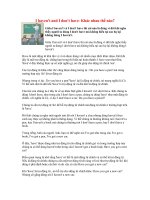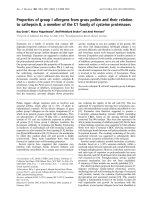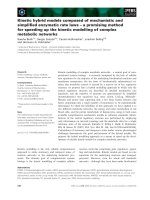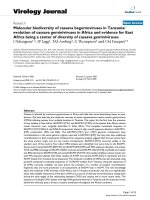Carrots and Sticks Don''''t Work- Build a Culture of Employee Engagement with the Principles of RESPECT
Bạn đang xem bản rút gọn của tài liệu. Xem và tải ngay bản đầy đủ của tài liệu tại đây (2.51 MB, 256 trang )
More Advance Praise for
Carrots and Sticks Don’t Work
“Carrots and Sticks Don’t Work is a profound book about the power
of respect. In today’s world, where ethics and consideration are at
an all-time low, Dr. Marciano has written a testament to what we all
need to remember: personal responsibility that earns respect.”
—Jane Boucher, author of How to Love the Job You Hate
“Dr. Marciano’s new book is loaded with compelling and relevant
case studies, which will inspire current and future leaders with new
insight and a road map for getting teams to make things happen!”
—Tony Hurst, Manager Service Operations,
Honeywell International
“Dr. Marciano goes right to the heart of true leadership. Many leaders
can get short-term results through the traditional model of rewards
and punishment. But true sustainable impact and results come from
building respect.”
—Garrett Ingram, AVP Managed Markets Strategy,
Novo Nordisk Inc.
“Outstanding! An excellent guide to help both managers and
individual contributors understand what employee engagement is and
why having it is critical for individuals and organizations to thrive.”
—Michael Stallard, author of Fired Up or Burned Out
“In my thirty-plus years in HR, I had not read an HR book before that
I would have said was a ‘must have’ textbook for any line manager . . .
but this is one!”
—Clinton Wingrove, EVP and Principal Consultant,
Pilat HR Solutions
“I wish this book had been written twenty years earlier. It would have
saved me a lot of mistakes.”
—Mark Straley, President, Ortho Clinical Diagnostics,
Johnson & Johnson
“Carrots and Sticks Don’t Work brings a clear understanding
to leadership by providing very useful methods that will enable
managers of people to connect with today’s evolutionary workforce.
As someone who has managed people for over thirty years and uses
engagement surveys in determining employee satisfaction, I can
affirm that Dr. Marciano’s book is a wonderful primer for all who lead
people in today’s world.”
—Diane Piraino-Koury, Owner/Operator,
McDonald’s Restaurant
“I plan on having all members of my management organization read
Carrots and Sticks Don’t Work. The RESPECT Model is an easy-touse process with many examples. I personally plan on using it both
inside and outside of work!”
—Jack Lally, Senior Manager, FedEx
“This book is a concise blueprint for creating a positive, cohesive
workforce.”
—A. Michael Hopp, Senior Vice President of Human
Resources, Mannington Mills, Inc.
“Finally, a book that conveys the key to employee motivation in our
contemporary workplace. The RESPECT Model explicitly shows that
when people are treated with respect they engage and work harder to
achieve the goals of the organization.”
—Arnold Endick, Workplace Environmental Analyst,
U.S. Postal Service, Retired
“Dr. Marciano encourages us to look at today’s challenging reality
through a new lens, and we emerge renewed and refreshed.”
—Eva G. Carmichael, Internal Consultant,
Superior Court of New Jersey
“Carrots and Sticks Don’t Work is a practical guide and reminder
of how we should all behave in both our professional and personal
lives. I think it’s a must read and one that will become a reference
for anyone that is interested in becoming a leader, becoming a better
leader, or knowing what to look for in a good leader.”
—Dave Hickey, CEO, Lumeta Corporation
“I was barely past the R in RESPECT and couldn’t wait to get back
to the office to try out the suggestions laid out in this book. A must
read for any manager or business owner who has ever wrestled with
employee productivity issues.”
—Michael Caldwell, Co-Founder/CEO,
GigMasters.com, Inc.
“Dr. Marciano gives great advice about what works—and what
doesn’t—to get maximum employee engagement and discretionary
effort.”
—Christopher Rice, President and CEO,
Blessing White, Inc.
“Carrots and Sticks Don’t Work is an easy read and an even easier
application that builds respect and dignity into everyday work life.”
—Ron Golumbeck, Vice President and Director of Human
Resources, ITT Industrial Process
“This book is a worthwhile read for organizations large and small,
executives, middle managers, supervisors, and human resource
professionals. Dr. Marciano’s commonsense approach is appealing in
today’s economy where nothing is more important than to harness
the loyalty, discretionary effort, and commitment of the workforce
through respect.”
—Catharine Newberry, former Chief Human Strategy
Officer, The Medicines Company
“This is a relevant and useful book for personnel management in
organizations of all sizes. The RESPECT Model is a friendly and
flexible tool for building a better working environment for employees
and supervisors and getting results for the organization.”
—Jose S. Azcona, President, Alianza Inmobiliaria
“Carrots and Sticks Don’t Work is a diamond in the rough of
leadership books. Dr. Marciano not only transforms the way we think
about employee engagement, but his research and insights argue for a
new dawn of business where respect should live at the forefront of all
of our value statements.”
—Daniel Rehal, President, Vision2Voice, Inc.
“In Carrots and Sticks Don’t Work, Dr. Marciano combines his
real-life leadership and consulting experience with an extensive
background in teaching and research to help employers create and
sustain a productive workforce in the twenty-first century.”
—Carl Sorensen, Associate VP Human Resources,
University of Richmond
“The RESPECT Model created by Dr. Marciano is the best human
resource program I have ever encountered. It’s a step-by-step
approach in creating an engaged employee. Engaged employees are
an asset to every employer and organization.”
—Carl Resnick, owner, Flemington Department Store
“Drawing from decades of research as well as personal and clinical
experience, Dr. Marciano explains how to avoid common managerial
mistakes that actually undermine employee motivation. Every
manager should read this highly insightful and engaging book.”
—Nicole Tuchinda, M.D., J.D., Associate,
Ropes & Gray, LLP
Carrots
and Sticks
Don’t Work
This page intentionally left blank
Carrots
and Sticks
Don’t Work
Build a Culture of Employee
Engagement with the
Principles of RESPECT ™
Paul L. Marciano, Ph.D.
New York Chicago San Francisco Lisbon London Madrid Mexico City
Milan New Delhi San Juan Seoul Singapore Sydney Toronto
Copyright © 2010 by Paul L. Marciano. All rights reserved. Except as permitted under the
United States Copyright Act of 1976, no part of this publication may be reproduced or distributed
in any form or by any means, or stored in a database or retrieval system, without the prior written
permission of the publisher.
ISBN: 978-0-07-173698-5
MHID: 0-07-173698-0
The material in this eBook also appears in the print version of this title: ISBN: 978-0-07-171401-3,
MHID: 0-07-171401-4.
All trademarks are trademarks of their respective owners. Rather than put a trademark symbol
after every occurrence of a trademarked name, we use names in an editorial fashion only, and to
the benefit of the trademark owner, with no intention of infringement of the trademark. Where
such designations appear in this book, they have been printed with initial caps.
McGraw-Hill eBooks are available at special quantity discounts to use as premiums and sales
promotions, or for use in corporate training programs. To contact a representative please e-mail
us at
TERMS OF USE
This is a copyrighted work and The McGraw-Hill Companies, Inc. (“McGrawHill”) and its
licensors reserve all rights in and to the work. Use of this work is subject to these terms. Except as
permitted under the Copyright Act of 1976 and the right to store and retrieve one copy of the work, you
may not decompile, disassemble, reverse engineer, reproduce, modify, create derivative works based
upon, transmit, distribute, disseminate, sell, publish or sublicense the work or any part of it without
McGraw-Hill’s prior consent. You may use the work for your own noncommercial and personal
use; any other use of the work is strictly prohibited. Your right to use the work may be terminated
if you fail to comply with these terms.
THE WORK IS PROVIDED “AS IS.” McGRAW-HILL AND ITS LICENSORS MAKE NO
GUARANTEES OR WARRANTIES AS TO THE ACCURACY, ADEQUACY OR
COMPLETENESS OF OR RESULTS TO BE OBTAINED FROM USING THE
WORK, INCLUDING ANY INFORMATION THAT CAN BE ACCESSED
THROUGH THE WORK VIA HYPERLINK OR OTHERWISE, AND EXPRESSLY
DISCLAIM ANY WARRANTY, EXPRESS OR IMPLIED, INCLUDING BUT NOT
LIMITED TO IMPLIED WARRANTIES OF MERCHANTABILITY OR FITNESS FOR A
PARTICULAR PURPOSE. McGraw-Hill and its licensors do not warrant or guarantee that the
functions contained in the work will meet your requirements or that its operation will be uninterrupted or error free. Neither McGraw-Hill nor its licensors shall be liable to you or anyone else for any
inaccuracy, error or omission, regardless of cause, in the work or for any damages resulting
therefrom. McGraw-Hill has no responsibility for the content of any information accessed through
the work. Under no circumstances shall McGraw-Hill and/or its licensors be liable for any indirect,
incidental, special, punitive, consequential or similar damages that result from the use of or inability to
use the work, even if any of them has been advised of the possibility of such damages. This limitation of
liability shall apply to any claim or cause whatsoever whether such claim or cause arises in
contract, tort or otherwise.
Dedicated to the one I choose every day,
Karen
This page intentionally left blank
xi
Contents
PREFACE .
. . . . . . . . . . . . . . . . . . . . . . . . . xiii
ACKNOWLEDGMENTS
INTRODUCTION:
. . . . . . . . . . . . . . . . . . . . xvii
The Story That Started It All . . . . . . . . . xix
CHAPTER 1
The Workplace “Carrot-on-a-Stick” . . . . . . . . . 1
CHAPTER 2
Reward and Recognition Programs Don’t Work . . 15
CHAPTER 3
Employee Engagement . . . . . . . . . . . . . 39
CHAPTER 4
The RESPECT Model: Building a Culture of
Employee Engagement . . . . . . . . . . . . . 63
CHAPTER 5
Recognition . . . . . . . . . . . . . . . . . . 83
CHAPTER 6
Empowerment . . . . . . . . . . . . . . . . .103
CHAPTER 7
Supportive Feedback . . . . . . . . . . . . . . 115
CHAPTER 8
Partnering . . . . . . . . . . . . . . . . . . . 131
CHAPTER 9
Expectations . . . . . . . . . . . . . . . . . . 145
CHAPTER 10
Consideration . . . . . . . . . . . . . . . . .163
CHAPTER 11
Trust . . . . . . . . . . . . . . . . . . . . . 181
CHAPTER 12
Implementing the RESPECT Model . . . . . . . .201
APPENDIX:
“Your Story” . . . . . . . . . . . . . . . . . . .209
REFERENCES AND RESOURCES
INDEX .
. . . . . . . . . . . . . . . . 211
. . . . . . . . . . . . . . . . . . . . . . . . . . 219
This page intentionally left blank
xiii
Preface
O
ver the past twenty years, I have dedicated
my life to helping leaders increase the human
capital of their organizations. During this time I
have learned that relationships, both personal and professional,
work only within the context of respect. Born of this concept
and supported by my own research as well as studies from
around the world, I developed the RESPECT Model to help organizations create cultures of respect and workforces of highly
engaged employees. The model has been embraced by diverse
organizations ranging in size from twenty to six hundred thousand employees, including manufacturing companies, medical
practices, sales organizations, pharmaceutical companies, consulting firms, schools, and government agencies. The enthusiastic adoption and success of this model is due to its simplicity,
power, effectiveness, and universal appeal. It works because all
human beings desire one thing: respect.
xiv
Preface
Who Will Benefit from This Book?
This book was written for leaders at all levels who wish to engage
the hearts and minds of their employees. The specific examples
and strategies will help managers, supervisors, team leaders,
executives, small business owners, and human resources professionals increase their organization’s human capital. Whether you
are a brand-new first-line supervisor or the CEO of a Fortune
500 company, the RESPECT Model will increase your leadership
effectiveness and the productivity of your employees.
What You Will Learn
In reading this book, you will learn the nuts and bolts of creating an engaged workforce, specifically:
1. Why traditional reward and recognition programs fail
2. The difference between engagement and motivation
3. How increasing employee engagement adds directly to
the bottom line
4. Why most approaches to increasing engagement are
based on unsound research
5. How to measure employee engagement in your
organization
6. The link between respect and engagement
7. The RESPECT Model
a. The power of an “actionable philosophy”
b. The seven drivers of RESPECT
c. Your current leadership effectiveness in showing
RESPECT
Preface
xv
d. Specific examples of RESPECT in action
e. Turnkey strategies and best practices to foster a
culture of RESPECT
By reading and applying the principles and strategies in this
book you will dramatically increase the commitment, loyalty,
and discretionary effort of your employees. Your people and
your organization will thrive in ways that you could not even
have imagined. Let the RESPECT Model do for you what it has
done for so many others—help you become a highly respected
leader that others want to follow.
This page intentionally left blank
xvii
Acknowledgments
T
hroughout my life I have been blessed with
extraordinary teachers and mentors.
I had the honor of attending Davidson College
as an undergraduate and to later serve on the faculty with those
I am proud to call my mentors, colleagues, and friends. I am particularly indebted to my advisor, Professor John Kello, who first
exposed me to the field of Organization Development and provided me with guidance, educational experiences, and opportunities far beyond my undergraduate years.
In the field of psychology, few are held in higher esteem than
Professor Alan Kazdin, my graduate advisor at Yale University.
Words cannot express my gratitude for the opportunity to work
with Alan and the entire Yale Psychology faculty. I am greatly
blessed and humbled for my experiences with Alan and the
“dream team” at the Child Conduct Clinic. No student ever had a
finer role model or received better training.
Sometimes the most important decisions in life occur before
we are born. My grandfathers, Lorenzo Marciano and Ludwig
Bemelmans, immigrated to the United States as young men with
nothing but the dreams of building a good life for themselves
xviii
Acknowledgments
and their families—even those they would never meet. It is difficult for me to comprehend their courage and strength. I owe
my grandfathers a debt of gratitude that I cannot repay but only
honor by making the most of the opportunities that they, as well
as my grandmothers and parents, set in motion.
While I could not appreciate it as a child, I want to thank
my mother and father for teaching me about respect and never
tolerating disrespectful behavior. I also want to thank them for
teaching me about hard work and to never take our freedoms for
granted. Their extraordinary sacrifices made it possible for my
brothers and me to attend college and follow our dreams. I can
only hope to be as selfless and loving a parent.
This book would not have been written if it were not for my
wife, Karen. She has been an inspiration and integral part of this
process from proposal to final edit. I could not imagine a more
loving, patient, and supportive partner and just don’t know what
I’d do without her.
I want to thank my clients over the past twenty years who
have entrusted their most valuable resources to my care. I would
like to give special thanks to Mannington Mills for their generous support of my research and acknowledge their care and
commitment to their employees as exemplified by their health
and wellness programming.
In all of my work as a teacher, therapist, consultant, entrepreneur, and group fitness instructor, I have sought to make a
difference in the lives of others. My inspiration throughout this
process has been to make the workplace a more respectful environment and to improve the quality of work life for all employees. I hope that you will bring the words on these pages to life
and make a difference to the people in your organization.
xix
Introduction
The Story That Started It All
T
here are times in our lives when what may appear
to have been a terrible decision turns out to be a
great learning experience and “blessing in disguise.” Early in my career I spent three months as director of
research at a small consulting firm. Although I didn’t realize it
at the time, this brief experience would profoundly shape my
understanding of employee motivation and engagement and
provide the insight that led me to create the RESPECT Model.
I share some of that experience with you now in the hope that
it will highlight for you the critical role respect plays in keeping
employees engaged.
The Last Guy Sat There
As anyone might be, I was excited and also a bit nervous for my
first day of work. I arrived forty-five minutes early and found
the door locked. I waited forty-five minutes before being let
in by Sherry, the company’s receptionist. She asked if I had a
meeting with someone. I had apparently not made much of an
xx
Introduction
impression when introduced as the new director of research
two weeks earlier by Mary and John, the owners of the firm. I
proudly announced “I work here!” and reintroduced myself. She
replied, “Oh yeah, you’re the new guy” and proceeded to hang
up her coat, get coffee, and begin the day’s crossword puzzle at
her desk.
I assumed that Mary or John would be in shortly to show me
around, introduce me to the staff, and discuss more fully their
specific goals and expectations. Not knowing quite what to do,
and receiving no direction or assistance from Sherry, I simply
waited in a chair across from her desk, which served as the
reception area. After thirty minutes, I finally asked if she knew
when Mary or John would be arriving. “Oh, they’re not coming in
today,” she replied. What? Could I somehow have screwed up my
starting date? Confused and embarrassed, I began to put on my
jacket and leave when the office phone rang. Sherry handed it to
me—it was John. He apologized for having been called away for
a last-minute meeting and assured me that Sherry would take
good care of me. I put Sherry back on the phone and she nodded a few times and hung up. She picked up a manila envelope
that had been sitting on her desk and said, “Here are the new
employee forms for you to fill out.”
Recognizing that a hard surface would be useful, I asked
where I might find an available desk. She walked me around the
corner and said, “The last guy sat there.” To the left of the desk
were a few dying plants and my new officemate, TJ, who warmly
introduced himself and welcomed me to the company. He then
offered to take me around and introduce me to the rest of the
staff. Now we were getting somewhere! As we went around the
office my new team members appeared engaged in a number
of different activities, including conversations on sports and
stocks, surfing the Web, and playing online solitaire. There was
a college intern, Elaine, who did appear to be working.
Introduction
xxi
After the tour, I went back to my desk and completed the
forms. I handed them to Sherry and asked if John had said what
I should do next. He had not. So, I asked TJ if he needed any
help. He smiled and said no. As I walked around the office reiterating my offer, I received several bemused looks and no takers.
I returned to my desk and thought: Have I been inserted into a
“Dilbert” cartoon?
Committed to doing something productive, I found the janitorial supplies and cleaned my desk and some bookshelves. I
then picked dead leaves off the plants, gave them a good watering, and moved them closer to a sunny window. I looked at my
watch and thought, “How could it only be 10:30 A.M.? What am
I going to do the rest of the day?” I remembered having come
across several boxes of pencils in my desk and took to sharpening them. When finished, I carefully packed the pencils back
into their boxes according to their length and placed them back
in my desk. It was to be one of the most satisfying and productive experiences of my tenure there.
TJ had been watching me “work” while talking to his girlfriend on the phone. When he hung up I told him that I was
bored out of my mind. He suggested that I learn to pace myself.
Taking pity on me, he handed me a stack of reports and said,
“You can read these over for typos if you’d like.” He then grabbed
his coat and said that he had to run out. Running sounded like a
good idea.
At noon Sherry came into my office and said that she wanted
to show me something. She walked me to the front door and
pointed to a small magnetic whiteboard with everyone’s name
written down the left side and two columns labeled “In” and
“Out.” My name had been added to the bottom of the list and a
small magnetic circle indicated that I was “In.” Everyone else’s
circles were in the “Out” column. Although I had actually brought
my lunch, there was no way that I was staying “In” and went to
xxii
Introduction
move my circle to “Out.” Sherry then explained that team members took turns answering the phones during her lunch break
and, as I was the only one left “In,” that would be me today. She
put on her coat and walked out.
I prayed for the phone not to ring. Mary called first. We chatted for a minute, and then she asked me to transfer her to TJ’s
voice mail. Of course, I had no idea how to do that and hung up
on her. Nor was I of any help to a client who called to schedule
an assessment for one of his employees. “Yes,” I told him, “I am
new.” I then did the only reasonable thing and took the phone off
the hook. As I sat there, I had to consider the very real possibility that I had made a very bad decision. Six years in graduate
school at Yale and here I was answering phones. I had walked
away from a tenure-track position at one of the best schools in
the country and was now sharpening pencils. I felt a wave of
nausea rush over me and considered simply walking out and
leaving a note. Of course, I would be sure to push my magnetic
circle to the “Out” column.
The time from 1:00 to 5:00 passed more slowly than any previous four hours of my life. As I sat at my desk, I thought of the
Seinfeld episode where George had gotten a job but had been
given nothing to do and spent the day sharpening pencils and
throwing them like darts into the fiberboard ceiling. I seriously
doubted anyone would notice. I glanced over at the dying plants
and realized that this was not an environment in which plants
or people could thrive. At 5:00, I pushed my circle to “Out” and
went home. I slept little that night as my thoughts raced between
“What have I done?” and “Surely things will get better once I
meet with John.”
On the second day, I was the first to arrive at 8:30 and again
waited for Sherry to unlock the door at 8:59. Upon seeing me,
she looked surprised and said, “You’re back.” Apparently, she
gave me more credit than I deserved. I checked “In.”
Introduction
xxiii
I spent the first part of the morning visiting the office plants
and staff. The plants seemed livelier than the day before. I could
not say the same of my colleagues. I had brought in my laptop
and replied to e-mails and read the news. When John checked
“In” at 10:30, I felt an incredible sense of relief. He greeted me
enthusiastically and congratulated me on finding my desk. I
twitched as I realized that the bar was even lower than I had
imagined. He told me that he had a great idea; he was taking me
shopping to get office supplies for my desk. I assured him that I
had plenty of well-sharpened pencils.
We retuned an hour later with several bags of supplies—
almost all of which I knew to be well organized in the stock
room. John suggested that I get my desk outfitted and then
come in to see him. I was so anxious to actually get to work that
I left most of the supplies in their bags and shoved them into
the desk drawers. Five minutes later, I was standing in front of
John’s office; he was on the phone but motioned for me to come
in and sit down. I sat and waited, and waited. I picked up a book
on his coffee table and started reading. He kept holding up his
forefinger and gesturing, “One more minute.” Thirty minutes
later he wrapped up the call and said, “Time for lunch. Come
on, I’m buying.” I smiled at Sherry as I walked by the board and
signed “Out.”
While at lunch, I was able to direct the conversation away
from college basketball long enough to get some direction
regarding my “work.” (It would prove to be the most focused
and informative meeting of my short tenure.) My first and most
important responsibility was to validate the assessment instrument that served as the core business product of the business.
The instrument was marketed as a personality and behavioral
assessment that could predict employee performance and was
being used by several Fortune 500 companies to make hiring,
promotion, and placement decisions.
xxiv
Introduction
The instrument had been purchased several years earlier
from a psychologist who assured Mary and John that it was valid
and reliable, although he did not provide any documentation. I
took the test, read the computer-generated report, and sensed
immediately that it was a bad instrument. With the raw data
of several thousand completed reports, it did not take me long
to confirm my suspicion. The instrument failed even the most
basic tests of reliability and validity. In fact, some of the scales
and the manner in which they were scored made no sense at all.
Had I still been teaching statistics and survey development, this
would have served as an ideal example of what not to do. The
report, which was generated and used to make decisions about
people’s careers, had all of the validity of a fortune cookie.
I explained my findings to Mary and John as straightforwardly as possible and let them know that they needed to
immediately stop using the instrument. Put simply, they were
committing fraud. John and Mary listened without comment
and then asked me to step outside the door. After a few minutes
Mary called me back in and said, “I think that pulling the instrument would confuse our clients.” I was speechless. Mary asked
if I could revise it—she liked this idea because they could then
market it as a new and improved version. I told her that it might
be possible to create a similar-looking instrument but that the
majority of existing items would have to be thrown out. I also
told her that the development and validation process would take
several months.
I spent the next six weeks creating, testing, editing, and
retesting items. After a dozen different versions I met with John
and Mary to let them know that we were ready to begin the pilot
study. As part of the research plan, four hundred employees
from their largest client were to be surveyed. Mary praised me
for a job well done and told me that plans had changed: there
would be no pilot study. She had confidence in me and the new









